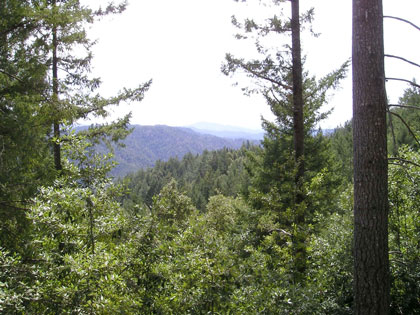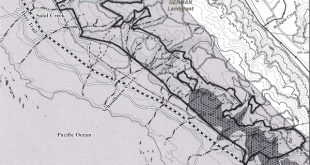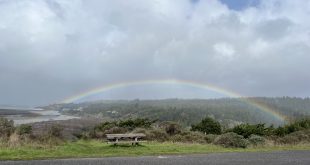| by Denny Rosatti March, 2013 Vibrant Bay Area reprinted with permission |

The modern-day Northern California land rush to convert forests to vineyards lost some steam last month.
The Preservation Ranch project, located in the northwestern hills of Sonoma County near the small hamlet of Annapolis, was a 20,000 acre proposal that would have permanently converted nearly 1,800 acres of timber forest to vineyards. In February, the Santa Rosa Press Democrat ($24.5 million deal to protect 20,000-acre Sonoma County forest, February 26, 2013) reported the deal between government agencies and private non-profit land trusts to purchase conservation easements. The deal, worth $24.5 million and set to close at the end of May, would involve a wide coalition of non-profit land trusts led by The Conservation Fund, including the California Coastal Conservancy, the Sonoma County Agriculture and Open Space District, and the Sonoma Land Trust.
Environmental activists have heaped deserved praise on those who worked to save these wild and forested lands. Project opponents had nicknamed the project “Devastation Ranch,” as its sheer scale and remoteness was a clear violation of all ecological ethics and values.
The grapes, proposed mostly for the ridgetops, would have required over 100 miles of wildlife fencing, drawn precious water supplies from sensitive tributaries of the Gualala River, and would have required extensive grading and road building on many miles of currently wild and forested areas. At times during the life of the project, the vineyards were paired up with over 100 McMansions in a remote section of rolling hills and forests.
“Devastation Ranch” would have been a climate change activist’s nightmare. Redwood forest, which would have been cut for the vineyards, is one of the highest-value carbon “sinks” naturally available, and the project placed people and infrastructure far from any services and with little to no workforce housing anywhere within a reasonable distance. The transit void is so obvious it barely deserves mentioning. Stream pollution, habitat disturbance, water diversion and Native American heritage site disturbance were also significant concerns.
While I feel a great sense of relief that the project appears to be headed out of the development pipeline and placed into permanent protection as a working sustainably harvested forest, it is frustrating to see the enormous amount of money needed to stop this project. CalPERS, California’s retirement fund, has agreed to sell the property, essentially to the public, for $24 million. That’s a loss of $4 million from what they paid for the property in 2004. It is deeply disturbing that this level of public and private charitable money had to be spent to do the job that Sonoma County Supervisors could and should have done for free.
Activists, led in recent years by the Annapolis based Friends of the Gualala River (FOGR- GualalaRiver.org), with support from Sierra Club, Sonoma County Conservation Action, partners in the local labor movement and numerous local and regional organizations, have been mobilizing voters for over 10 years to oppose this one project in its various forms.
Through extensive grassroots outreach and exhaustive public lobbying campaigns, the public was clearly telling supervisors not to let those beautiful and out-of-the-way ridge tops be permanently clear-cut for grapes and expensive estate homes.
The Sonoma County Board of Supervisors dodged a political bullet that would have put them in the hot seat, with the destruction of our precious forests hanging in the balance. The General Plan amendments that Preservation Ranch needed were discretionary, yet politically charged, as pressure from industry lobbyists and local business groups was destined to be intense, The Sonoma County Climate Action Plan, which calls for the reduction of greenhouse gases, doesn’t have policy language to prevent trading such valuable carbon sinks like redwood forest for grape vines. And had they put in place a strong timber conversion ordinance, which at one time had a proposed provision prohibiting timber conversion on parcels above 7 acres, supervisors would have avoided the possibility of this large scale clear-cut for vineyards.
It’s dangerous to leave big-money land use decisions in the hands of politicians. Without the proper land use regulations in place (such as a strong Timber Conversion policy), the public got the best possible outcome from a very bad proposal, and gratitude goes to those in the aforementioned groups and local leaders who made it happen.
Thankfully, and strangely, the economy tanked and CalPERS was forced to cover their losses in order to get out with 80% of their initial investment intact. This left the door open to conservation groups to step in to clean up the mess. A stronger regulatory framework may have dissuaded CalPERS or other would be forest-converters to vineyards from investing in such speculative and unsustainable projects in the first place.
Peter Baye, a longtime project critic and volunteer with the Friends of the Gualala River, has expressed hope that this will be the last fight of its kind on the North Coast. “Preservation Ranch’s final demise will put the nail in the coffin of a bankrupt business and land use model for North Coast forestlands,” he said.
With at least one large scale project still in the works, a 154-acre clearcut proposed by the Spanish-owned Artesa Winery, I hope Mr. Baye is correct and this causes those involved in forest conversion to vineyard projects to pause. I eagerly look forward to an access agreement being worked out quickly on the Preservation Ranch property, to grant the public an up-close view of the beauty and utility in their investment. I personally intend to get out on the land as soon as the ink dries.
For additional information, see:
 $24.5 million deal to protect
$24.5 million deal to protect
20,000-acre Sonoma County forest
February 26, 2013
Santa Rosa Press Democrat
“Preservation” Ranch
 The so-called “Preservation” Ranch is a 19,300 acre development in the heart of the Gualala River watershed. Premier Pacific Vineyards plans to destroy and fragment coastal redwood forest to plant grapes on the ridgetops – and call that “preservation.”
The so-called “Preservation” Ranch is a 19,300 acre development in the heart of the Gualala River watershed. Premier Pacific Vineyards plans to destroy and fragment coastal redwood forest to plant grapes on the ridgetops – and call that “preservation.”
Artesa Sonoma forest-to-vineyard conversion
 CAL FIRE has approved the Environmental Impact Report (EIR) for Artesa Winery’s controversial plan to clear-cut 154 acres of coastal redwood forest to plant a vineyard in Annapolis. The EIR claims that the project will have no significant environmental or cultural impacts.
CAL FIRE has approved the Environmental Impact Report (EIR) for Artesa Winery’s controversial plan to clear-cut 154 acres of coastal redwood forest to plant a vineyard in Annapolis. The EIR claims that the project will have no significant environmental or cultural impacts.
 Friends of Gualala River Protecting the Gualala River watershed and the species living within it
Friends of Gualala River Protecting the Gualala River watershed and the species living within it


